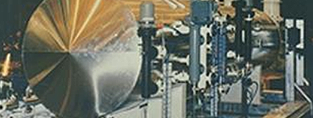
- (03) 5909 8218
- enquiry@fusionweld.com.au
Pressure Vessel External Pressure Calculations and Capacity
November 17, 2016

Diligent engineering design processes use pressure vessel external pressure calculations to determine fluid storage parameters and ensure an operational safety margin is properly established. Basically, these are practical storage containers, chambers that hold dangerous fuels and chemicals, but these practical attributes can be expressed in engineering mathematics, the language that initially created their high-performance profiles. The calculations begin with a basic differential formula.
Core Pressure Relationship Theories
The actual design of the vessel takes its cue from two basic functions. There's the internal stored energy, obviously, which is generated by the stored fluid. This variable is calculable and quantifiable. Conversely, the exterior pressure is harder to determine. If it is atmospheric pressure, then this value can be subtracted from the stored pressure to establish the design pressure. Interestingly, this value isn't always easy to translate. Jacketed and multi-chambered containers, for example, add external stress factors to the formula. Likewise, possible vacuums and steam condensation conditions represent variable subsets that must be accounted for during the initial design stage.
Load Carrying Capacity
Pressure vessel external pressure calculations are affected by the above conditions, but those same variables then influence the loading capacity of the metal container. Why should this unlikely relationship exist? Well, the metal plates are spaced with a certain amount of rated elasticity, which means the container is rated to bulge ever so slightly. Obviously, this attribute will be altered by the external pressure, its constancy or habitual transience. Even a pressurized steam cleaning procedure can alter this calculation, so all vessels require a fundamental external pressure rating, even if it's just to protect the local environment.
Implementing Calculated Pressure Designs
The thickness of the metal plating is assessed first. This important engineering specification is then supported by other internal features. This latter mandate includes stiffening rings and weld integrity. Of course, the addition of a supplementary mechanical feature means the addition of a new variable to the external pressure calculation. In doing so, we measure the distance between the thickening rings, the thickness of the vessel, and use the geometry of the container to properly characterize the formula. Finally, these variables are calculated against material constants, including the modulus of elasticity, to complete the calculation.
The exterior environment is not a negligible mathematical constant, for many external conditions influence this pressure-oriented quantity. Indeed, this is a mathematical variable, one that's influenced by a host of factors, including altitude, chambered conditions, and the possibility of a vacuum.
Contact Details
Fusion - Weld Engineering Pty Ltd
ABN 98 068 987619
1865 Frankston Flinders Road,
Hastings, VIC 3915
Ph: (03) 5909 8218
Optimized by NetwizardSEO.com.au
Recent Posts
- Compressed Hydrogen Storage Vessels: Material Selection, Design & Australian Standards
- Welding QA/QC in Oil & Gas Pressure Vessel Fabrication – Ensuring Code Compliance
- AS1210 vs ASME VIII Pressure Vessel Code: Key Differences for Australian Projects
- Mitigating Hydrogen-Induced Cracking in Pressure Vessels: Engineering and Material Strategies
- Storage Tank Solutions Australia: Field-Erected, Prefabricated & Self-Bunded Explained
- Reducing Environmental Risks: Self-Bunded Tanks in Australian Oil & Gas Operations
- Precision in Production: How Pressure Vessels Are Manufactured for Industrial Safety
- Shell & Tube Heat Exchangers: Improve Thermal Control & Energy Recovery in Petrochemical & Pharmaceutical Plants
- In-Service Inspection for Compressed Air Receivers for Power Plant Shutdown Prevention
- Power Plant Pipe Spooling Fabrication – Get Rapid, Code-Compliant Spools Ready for Installation
- Field Erected Tanks: Safe, Reliable On-Site Fuel Storage Solutions in Australia
- Custom Pressure Vessel Fabrication for Flammable Gases
Posts 2025
- Compressed Hydrogen Storage Vessels: Material Selection, Design & Australian Standards
- Welding QA/QC in Oil & Gas Pressure Vessel Fabrication – Ensuring Code Compliance
- View all articles…
Posts 2024
- Large Process Vessels: Optimising the Design for Maximum Efficiency [2025]
- Pressure Equipment Management System Installation: Detect Equipment Faults Early
- View all articles…
Posts 2023
- Pressure Piping System Inspection: A Gift of Safety for the Holidays
- Deaerator Inspections by Fusion-Weld Engineering and How They Reduce System Downtime
- View all articles…
Posts 2022
- How Fusion Weld Keeps Up With AS-NZS ISO 9001:2008 Standard
- Boiler Equipment Safety Inspection During the Summer Season
- View all articles…
Posts 2021
- Avoid These Factors and Practices that Contribute to Sealing Damage in Pressure Vessels
- Do's And Don'ts Of Industrial Boiler Inspection And Maintenance From Fusion-Weld
- View all articles…
Posts 2020
- What are the Risks and Hazards Involved in Pressure Vessel Equipment?
- How to Know if Your Pressure Equipment Needs Repair or Replacement?
- View all articles…
Posts 2019
- Factors that Contribute to Pressure Vessel Failure
- Pressure Vessel Regulations in Australia: What are the Mandatory Requirements?
- View all articles…
Posts 2018
- Pros and Cons of Spherical vs. Cylindrical Pressure Vessels
- What are the Different Hazard Levels in Pressure Vessels?
- View all articles…
Posts 2017
- Transportable Pressure Vessels: The Importance of Inspection and Safety Checks
- Fracture Mechanics and Stress Analysis of Cracks in Pressure Vessels
- View all articles…
Posts 2016
Posts 2015
- What Are Deaerators & Feedwater Vessels?
- Precautions and Safety for Compressed Air Receiver Vessels
- View all articles…
Posts 2014
- Demonstrating In-process Inspection Procedures
- Static Grounding Practices and Standards
- View all articles…